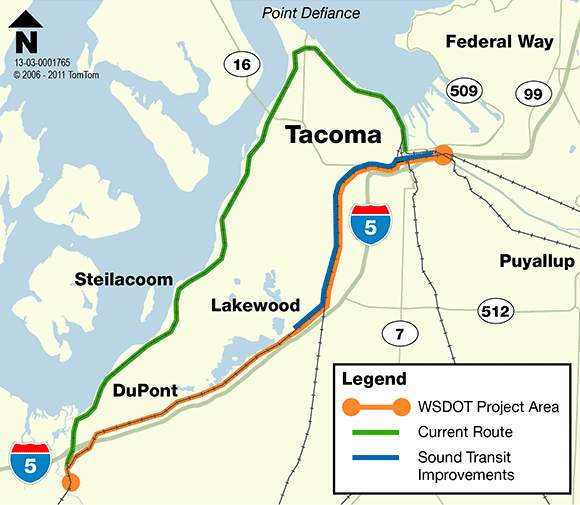Investigators focus on speed, distractions in Amtrak crash
Claudia Cowan reports from DuPont, Washington.
A resounding multi-agency failure led to the deadly 2017 Amtrak train derailment, investigators revealed Tuesday as part of a sprawling autopsy of the accident that spread blame far and wide: with those operating the train, those training the operators and those in charge of making sure the entire operation was safe.
The National Transportation Safety Board said Amtrak Cascades train 501 was going more than twice the speed limit around a dangerous curve on Dec. 18, 2017 when it derailed on an overpass over Interstate 5 in Dupont, Wash. and the engine and four cars plummeted onto the highway, striking eight vehicles.
Three people on board the train were killed, while 57 passengers and crewmembers were injured along with 8 people on the highway below, according to the NTSB.
"Could this accident have been prevented? The answer is a resounding yes," NTSB Chairman Robert Sumwalt said in an announcement of the findings.
AMTRAK'S DEADLIEST CRASHES IN RECENT YEARS
Federal investigators said the crash happened after the engineer lost track of where he was on the route and was going 78 mph when he hit the 30-mph curve. But instead of blaming the engineer, the NTSB cast a wide net that included the various agencies that constructed and operated the line.
"It set up the engineer to fail," Sumwalt said.

In this Dec. 18, 2017, file photo, cars from an Amtrak train lay spilled onto Interstate 5 alongside smashed vehicles as some train cars remain on the tracks above in DuPont, Wash. (AP Photo/Elaine Thompson)
Investigators took aim at the transit agency Sound Transit for not sufficiently mitigating the danger of the sharp bend, Amtrak for not better training the engineer, the Washington State Department of Transportation for not ensuring the route was safe before green-lighting a passenger train and the Federal Railroad Administration for using rail cars beneath regulatory standards.
“I’m just amazed at the amount of failure that goes along here,” NSTB Vice Chairman Bruce Landsberg said at the hearing, according to the Seattle Times. “We have five or six or seven different organizations that all say safety is their primary responsibility, and yet nobody seems to be responsible. And it just flows all the way throughout the entire operation here, from the very top management down to the lower levels.”
The crash happened on the first day the train was operating on a new bypass route between Seattle and Portland that was created by refurbishing freight tracks along the major interstate. The $180.7 million project was aimed at speeding up service by bypassing an old route that had a number of curves, single-track tunnels and freight traffic.

A map of the new Amtrak route illustrates where the line would deviate from the existing line, and take passengers on a more straightforward route between Tacoma and Olympia. (Washington State Department of Transportation)
Amtrak President Richard Anderson said shortly after the crash that Positive Train Control – the technology that can slow or stop a speeding train – wasn’t in use on the stretch of track where the derailment unfolded.
The engineer appeared to apply the brakes but did not put the brakes in emergency mode. He told federal officials he was aware of the sharp curve — he'd operated the locomotive three times on that track and observed the route another 7-10 times — but lost track of where the train was on the route.
AMTRAK ENGINEER MISSED SPEED-LIMIT SIGNS BEFORE DEADLY DERAILMENT IN WASHINGTON, NTSB SAYS
NTSB officials determined the engineer, who had only done one southbound trip on the route, missed the one speed-limit sign two miles ahead of the sharp turn and had "insufficient training on both the route and the equipment."
Many of the injuries came from rail cars that did not meet current crashworthiness standards, and were "permitted to operate through a grandfathering agreement with the Federal Railroad Administration, was structurally vulnerable to high-energy derailments or collisions," according to the NTSB.
A lawyer representing dozens of victims told Q13 News on Tuesday the NTSB findings show the lack of oversight by many.
"It's all too easy to blame it on individuals but this was an institutional problem, and it involved a number of institutions Amtrak first and foremost," David Beninger told Q13.
The final NTSB investigation report will be available in several weeks, according to the agency.
CLICK HERE FOR THE FOX NEWS APP
Seattle-based Sound Transit issued a statement Tuesday afternoon, calling the derailment "a terrible tragedy that sears in the memory of all of us at Sound Transit."
"While Sound Transit does not operate any service in the segment of track where the accident took place, as owner of the track we commit to closely reviewing the NTSB's report and implementing recommendations in collaboration with Amtrak, the Washington State Department of Transportation, BNSF and the Federal Railroad Administration," the agency said.
Amtrak also issued a statement Tuesday.
"We remain deeply saddened by the loss of life and injuries due to this tragic event," Amtrak said. It said it has already implemented a number of changes, including the creation of a new "safety organization" and the development of a strategic plan to "maximize the effective use of simulators in training, qualification and certification of Amtrak employees.
Fox News' Katherine Lam and the Associated Press contributed to this report.




